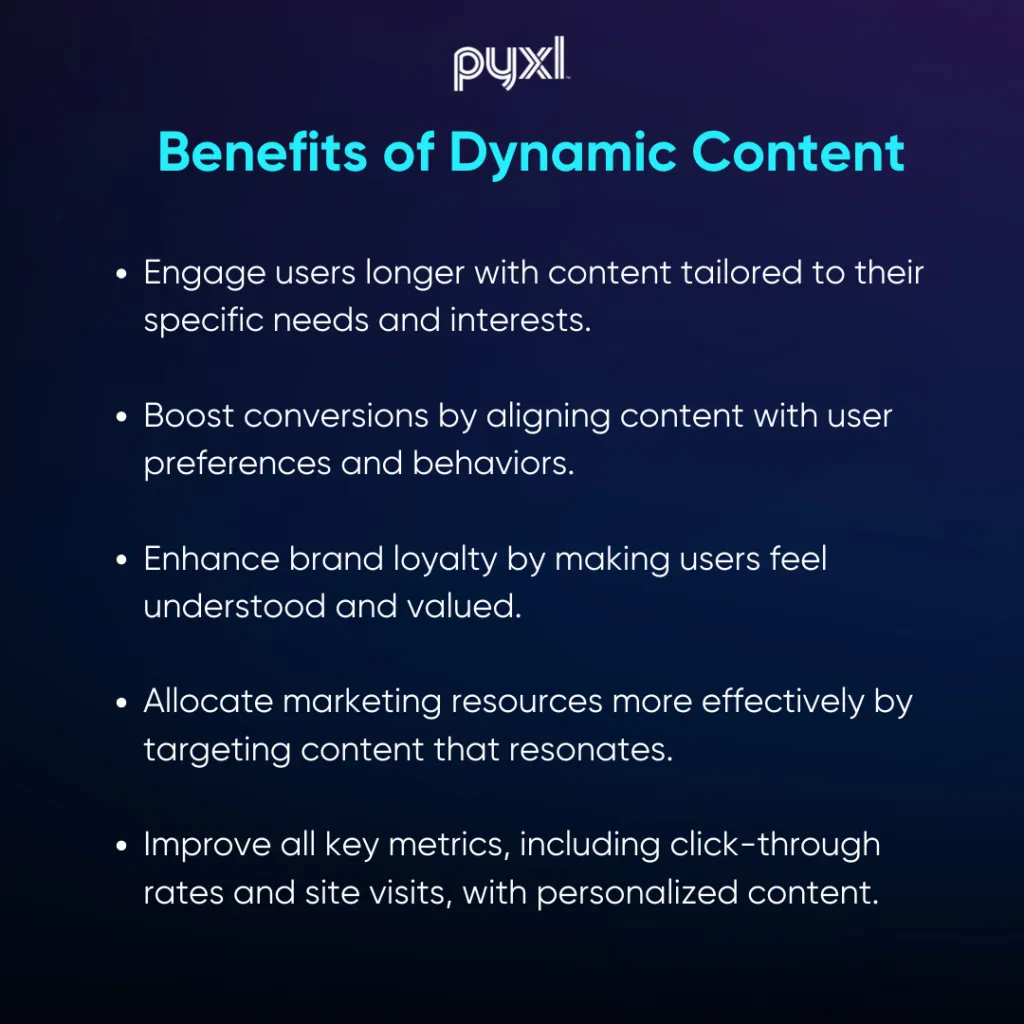Leveraging Dynamic Content for Personalized User Experiences
80% of consumers are more likely to engage with a company that offers personalized experiences. It’s clear that the ability to tailor content dynamically to meet the individual needs of users isn’t just a nice-to-have; it’s a must-have. Personalizing content is a tangible, and crucial, strategy for enhancing user engagement and boosting conversion rates.
Whether it’s a first-time visitor or a returning customer, dynamic content crafts a unique interaction for every user, making every digital touchpoint a personalized experience
Let’s explore the processes and tools that help create this personalized user experience, with a special focus on integrating HubSpot’s dynamic content capabilities and cutting-edge custom AI solutions.
Understanding Dynamic Content and Its Importance
Dynamic content refers to web elements that change based on the behaviors, demographics, preferences, and interests of the user. It creates an adaptive and interactive experience that is uniquely tailored to each visitor. Unlike static content, which remains the same for every user, dynamic content can change from one visit to the next, providing a personalized approach that feels both engaging and relevant.
For example, while a static webpage might show the same standard welcome message to every visitor, a dynamic webpage could greet returning visitors by name and display news or offers tailored to their interests. Similarly, while a static ecommerce site might show the same product listings to everyone, a dynamic site can adjust displayed products based on a user’s past browsing behavior or purchase history.

By harnessing the power of dynamic content, businesses can create a more fluid and engaging digital environment that not only meets but anticipates the needs of their users. In the following sections, we will delve into the specific processes and tools that make this sophisticated level of personalization possible, focusing on how technologies like HubSpot and bespoke AI solutions can be seamlessly integrated to enhance these efforts.
Processes for Creating Dynamic Content
Creating dynamic content is a multi-step process that utilizes advanced technology to gather, analyze, and deploy personalized content tailored to each user’s unique preferences and behaviors. Here’s how it’s done:
1. User Identification and Data Collection
To deliver personalized experiences, the first step involves identifying and understanding your users. This is achieved through:
- AI and Machine Learning Models: These powerful tools analyze user interactions, behavior on the site, and engagement metrics to gain insights into user preferences and needs. AI can predict user behavior by identifying patterns and trends in data.
- Cookies and Tracking Pixels: These are essential for tracking user activity both within and outside your website. They help build a comprehensive profile of each visitor, including their browsing habits, purchase history, and more.
- Interactive Elements: Incorporating interactive features like quizzes, surveys, and polls directly into your content not only engages users but also provides valuable data about their preferences and decision-making processes.
2. Data Analysis and Segmentation
Once data is collected, the next phase is analyzing and segmenting it to form actionable insights:
- Big Data Analytics: Utilizing platforms like Tableau allows businesses to handle large volumes of data, identifying behavioral patterns that segment users effectively.
- Customer Data Platforms (CDPs): These platforms consolidate data from various sources to create a unified customer profile. This holistic view is crucial for precise segmentation and developing rich user personas.
- Developing Personas: With the insights gained, marketers can create detailed personas that reflect different segments of the audience. These personas include demographic, behavioral, and preference-based characteristics that guide content personalization.
3. Dynamic Content Delivery
Delivering personalized content involves sophisticated systems that respond in real-time to user interactions:
- AI-driven CMS and Personalization Engines: Systems like Adobe Experience Manager and others use AI to dynamically alter content based on the specific personas and segments identified earlier.
- A/B Testing and Machine Learning: Ongoing testing and optimization are vital. A/B testing various content versions helps determine what works best for different segments, while machine learning algorithms continually refine the personalization process based on user reactions and conversions.
4. Emerging Technologies and Compliance
Staying ahead involves not only leveraging current technology but also preparing for future innovations:
- Predictive Analytics: This technology forecasts future behaviors based on historical data, allowing businesses to proactively deliver content that meets emerging needs.
- Blockchain and 5G/Edge Computing: Blockchain can enhance privacy and security by giving users control over their data, while 5G and edge computing reduce latency, enabling real-time personalization even in mobile and remote environments.
- Privacy and Compliance: With all this technology comes the responsibility to protect user data. Ensuring compliance with global data protection regulations like GDPR and CCPA is crucial. Transparent data collection practices and providing users with control over their data are essential components of a trustworthy dynamic content strategy.
Through these sophisticated processes and tools, businesses can create a seamless and personalized user experience that not only meets but anticipates and adapts to the needs of their users. This dynamic approach is integral to modern digital marketing, driving engagement, satisfaction, and conversion.
Tools for Dynamic Content
Creating dynamic content requires the right tools. From advanced platforms like HubSpot to customizable AI solutions and integrations with WordPress, here’s a look at some of the key tools that can help you personalize and enhance your web content.
HubSpot’s Dynamic Content Features
HubSpot offers robust features to support dynamic content creation through its smart content modules and dynamic pages, making it easier to tailor content to individual user preferences:
- Smart Content Modules: These modules allow you to customize content directly in the HubSpot editor based on user data. You can display different versions of content like text, images, CTAs, and forms based on the viewer’s lifecycle stage, membership in a list, or device type.
- Dynamic Pages: HubSpot also enables the creation of dynamic web pages that automatically adjust content based on user data stored in HubSpot CRM or provided by the user during their interactions on the site. This feature is particularly useful for personalizing experiences at scale.
Custom AI Solutions
Integrating custom AI tools with platforms like HubSpot can significantly enhance the level of personalization:
- CRM Analytics: By analyzing data collected through user interactions, demographics, and firmographics, tools like our AI Sales Assistants can help determine future behavior to deliver tailored content for different users.
- AI Content Generation: AI tools can automatically generate content that is optimized for SEO and personalized for individual users, based on their past behavior and engagement patterns.
- AI-powered Chatbots: These can provide real-time, personalized interactions with users, guiding them through the website and helping with queries, which enhances user engagement and satisfaction.
Custom AI solutions enhance website personalization by tailoring content dynamically to individual user behaviors and preferences. These powerful tools can integrate seamlessly with platforms like HubSpot, enabling businesses to deliver uniquely personalized experiences.
For instance, our work with Relat demonstrates the transformative potential of custom AI. We developed a Generative AI Assistant that significantly enriches sales and business development outreach by providing personalized content based on the latest, relevant articles tailored to each recipient’s interests.
Through predictive analytics, AI content generation, and AI-powered chatbots, these solutions adapt in real time to user interactions, ensuring every digital touchpoint is engaging and relevant.
WordPress and AI Integration
WordPress, being a flexible and widely used CMS, offers several capabilities for integrating AI to enhance dynamic content:
- AI Plugins for Personalization: Plugins use AI to recommend articles to users based on their browsing history, similar to how Netflix suggests movies.
- Content and SEO Optimization: AI-driven tools can help optimize content for search engines in real-time, suggesting improvements and helping achieve better rankings.
- User Analytics: AI can analyze user data collected via WordPress to offer insights that help further refine content strategies.
- Integration with IBM Watson or Google AI: Integrating these powerful AI services with WordPress can provide advanced content analysis, translation, and personalization capabilities. For example, IBM Watson can enhance user profiling and content customization through natural language understanding and personality insights.
Each of these tools plays a critical role in the dynamic content ecosystem, helping businesses create more engaging and personalized user experiences. By leveraging HubSpot’s capabilities for smart content management, custom AI solutions for deeper personalization, and WordPress’s flexibility for AI integration, companies can set a new standard for user engagement on their digital platforms.
Key Takeaways
Leveraging dynamic content is crucial for creating highly personalized user experiences that drive engagement and conversions. By utilizing platforms like HubSpot in conjunction with custom AI solutions, businesses can tailor content dynamically to meet the unique preferences of each visitor at scale. This synergy not only enhances user satisfaction and loyalty but also optimizes marketing resources and boosts overall business growth.
Are you ready to transform your digital marketing efforts with dynamic content? Contact us today to learn more about setting up dynamic content systems or to schedule a consultation for our AI sales assistant solutions. Let us help you create a more personalized and engaging user experience that delivers results.
Updated: Nov 15, 2024
 Julia Smeltzer
Julia Smeltzer Kati Terzinski
Kati Terzinski Erin Murray
Erin Murray